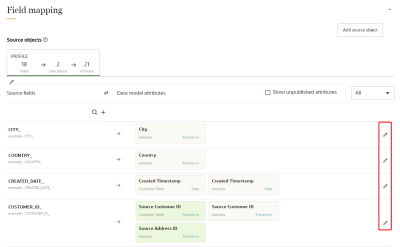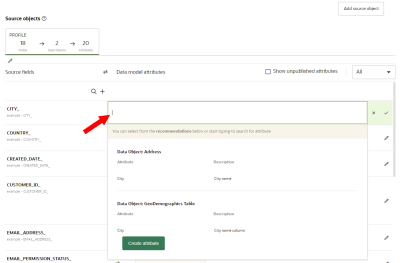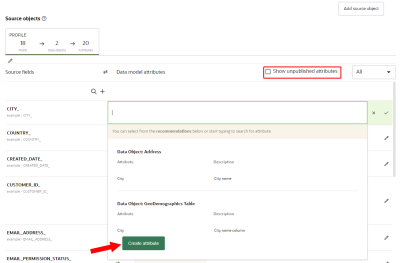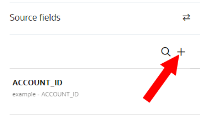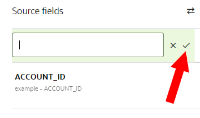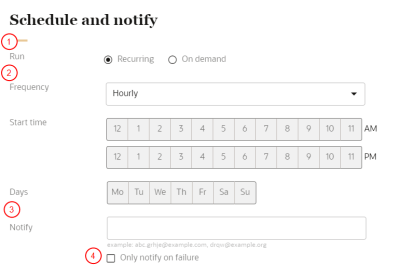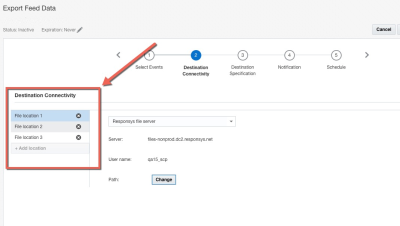Setting up the import of data from Oracle Responsys
After setting up the export of data to Oracle Responsys, you will need to import behavioral and profile data from Oracle Responsys into Oracle Unity. This data will then be incorporated into campaigns you create in Oracle Unity.
Learn more about correctly formatting source files and ingest jobs so that you can successfully import data:
-
Ensure source files are formatted correctly by reviewing CSV file standards for Oracle Unity and supported CSV parsers.
-
Review how to import empty or null data and the restrictions on empty/null data in the Oracle Unity data model.
Set up import of profile data
To import profile data from Responsys, you will need to do the following:
- Step 1: Create connect job in Responsys
- Step 2: Create a Secure FTP source
- Step 3: Create an ingest job with the ResponsysProfile field mapping template
- Step 4: Set up deduplication rule
Step 1: Create connect job in Responsys
To create the connect job, log in to Responsys and follow the steps for creating a connect job to export profile data.
Step 2: Create a Secure FTP source
To create the source, follow the steps for creating a Secure FTP source in Oracle Unity. This will configure the source of data in Responsys that Oracle Unity will use to retrieve profile data.
Step 3: Create an ingest job with the ResponsysProfile field mapping template
You will need to create an ingest job with the ResponsysProfile automated field mapping template. This will configure the data feed that will retrieve the profile data in Responsys. Review all the fields that are being imported from Responsys and make sure they are mapped correctly to the Oracle Unity data model. You can make changes as needed to the template and manually add additional profile fields.
To create the ingest job:
-
Click the Oracle icon
 in the bottom-right corner to open the navigation menu.
in the bottom-right corner to open the navigation menu.
- Select Data feeds.
- In the top-right corner, click Create data feed, then select Ingest job.
The Create ingest job page is displayed.
Step 1: Define job details
The job details section allows you to define how the ingest job will display in Oracle Unity.
To define the job details:
- Enter the details for the ingest job.
- Name: Enter a name. The name must be 1 or more characters, up to a maximum of 50. Use only letters (a–z and A–Z), numbers (0–9), underscores (_), hyphens (-), and spaces. The first character cannot be a space.
-
Job ID: The unique system identifier that is auto-populated from the job name you enter. You can't change this value after you create the job.
- Description: Enter a description. This field is optional, but it is highly recommended to add descriptions for any entity created. This helps all other users get additional context when using and navigating Oracle Unity. The description can have a maximum of 512 characters with no restrictions on characters used. You can use characters from all languages supported in the language settings.
- Source: Select the Secure FTP source you created previously. Review the details and make sure they are accurate.
- Once you have confirmed that the details are correctly configured, click Continue.
Step 2: Field mapping
You will select the ResponsysProfile automated field mapping template.
To complete automated field mapping:
- Under Automated, use the drop-down list to select ResponsysProfile.
- Click Continue.
- Make changes as needed by completing Step 3: mapping source object fields to data model attributes.
Step 3: Mapping source object fields to data model attributes
Note: You cannot access or search for hidden data objects and attributes for field mapping. Learn more about Hidden data model items in ingest jobs.
To map source object fields to data model attributes:
- Review the mapping of source fields and data model attributes. If needed, click Edit
 to update the field mapping.
to update the field mapping. - A list of recommended attributes may display for you to add. You can also use the search field to find attributes to add. You can search by data object name, attribute name, or attribute description.
- If you need to add an attribute that is not currently part of the data model, click Create attribute. Attributes you create will need to be published before the ingest job runs. You can review attributes that need to be published by clicking the checkbox for Show unpublished attributes. Learn more about Creating attributes and Publishing changes.
- To add the attribute, click the Checkmark
 .
. - To add a transformation on an attribute, click Transform.
- Concatenation transformation
- Date transformation
- Lookup/static transformation
- URL transformation
- Hash transformation
- Prefix-Suffix transformation
- Replace transformation
- Substring transformation
- Trim transformation
- To add another source object to be mapped, click Add source object.
Learn more about the different transformations available:
Important notes about configuring field mapping
-
A single source field can be mapped to one or more data model attributes. Conversely, one or more source fields can be mapped to a single data model attribute. If you map multiple source fields to a single data model attribute, you want Oracle Unity to store multiple values in that one data model attribute. Because of this, you need to ensure you select the appropriate transformation, so that Oracle Unity can correctly combine those multiple values.
- A notification will display if not every data object used in a mapping has its source mapped to an incoming field. Mapping all source data object IDs ensures that duplicate data is removed before it is stored in the system. Review the Source data object IDs not mapped notification before completing field mapping. The notification will identify each unmapped data object with a color.
- A red circle indicates that the unmapped source data object ID (SourceXID attribute) will cause the ingest job to not import the data successfully, even if the ingest job successfully completes. This is because the Incoming records flag for the data object is set to No (insertOnly parameter set to false). Learn more about the Incoming records flag.
- A yellow circle indicates that the source data object ID (SourceXID attribute) is unmapped, but the ingest job will still successfully import the data. This is because the Incoming records flag for the data object is set to Yes (insertOnly parameter set to true). If the SourceXID attribute is not mapped, Oracle Unity will automatically add a unique identifier to the SourceXID attribute when the data is imported. Learn more about the Incoming records flag.
Example: You map the First name attribute from the Customer data object to the FirstName source field in the sample file. You must also map the corresponding SourceCustomerID attribute in the Customer data object to a source field in the sample file so that the data can be successfully imported. This is because the Incoming records flag for the Customer data object is set to No.
Example: You map the Order Total attribute from the Event data object to the OrderTotal source field in the sample file, but you don’t map the SourceEventID attribute to a source field. You will receive a warning the source data object ID is unmapped, but the ingest job will still be able to import the data successfully. This is because the Incoming records flag for the Event data object is set to Yes.
Step 4: Managing source fields
You can create new source fields if you need to update the field mapping. To search through the existing list of source fields, click Find ![]() next to Source fields.
next to Source fields.
You can also edit and delete existing source fields if you need to update the name of the field or remove fields that you no longer need. Source fields you delete will also remove any field mappings you configured for that field.
To create new source fields:
- Next to Source fields, click Add
 .
. - Enter the name of the source field.
- Click the Checkmark
 .
. - Update the source field as needed by mapping it to data model attributes.
To edit source fields:
- Hover your mouse over the source field name you want to update and click Edit
 .
. - Enter the new source field name and click the checkmark
 .
.
To delete source fields:
- Hover your mouse over the source field name you want to remove and click Delete
 .
. - Review the confirmation message and click Yes.
Step 6: Schedule and notification settings
You will need to configure the schedule and notification settings for the ingest job.
To schedule the ingest job and define the notification settings:
- Configure the schedule for the ingest job:
- Click Recurring to automatically run the job on a regular schedule.
- Click On demand to run the job as needed.
- If the job is recurring, select the Frequency, Start time, and Days it will run.
- In the field for Notify, enter the email addresses of people to be notified when the job runs. Separate multiple emails with a comma.
- If you only want a notification if the job fails, click the checkbox for Only notify on failure.
Step 6: Save and publish the ingest job
After saving the ingest job you will need to publish the changes before it can run.
To save and publish the ingest job:
- Scroll to the top of the page and click Save or Save and close.
- Follow the steps for Publishing changes.
When the publishing task is completed, the ingest job can run. Learn more about Managing ingest jobs.
Step 4: Set up deduplication rule
You will need to log in to Oracle Unity and set up a deduplication rule on the SourceCustomerID attribute. This allows Oracle Unity to match and link customer records from Responsys profile data to any other customer records originating from other systems, such as transactional data. When complete, the deduplication rule ensures that multiple records belonging to the same customer don't count as more than one person and are properly linked. Learn more about using the Unity API from the Oracle Unity Developer Help Center.
Set up import of behavioral data
To import behavioral data from Responsys, you will need to do the following:
- Step 1: Update Contact Event Data connect job in Responsys
- Step 2: Create a Secure FTP source
- Step 3: Create an ingest job with the ResponsysEmailEvents field mapping template
- Step 4: Set up deduplication rule
Step 1: Update Contact Event Data connect job in Responsys
You will need to log in to Responsys and update the existing connect job you use to export Contact Event Data. Learn more about Managing Connect Jobs and follow the steps for Changing Connect Jobs. After clicking Edit, go to the Destination Connectivity section and add a new file location destination for Oracle Unity Event Data.
If you don't have an existing connect job for Contact Event Data, create a new connect job to export Contact Event Data.
Warning: If you have an existing connect job to export Contact Event Data (CED), then you must update that existing job and not create a new one. Creating a new connect job so that you have multiple connect jobs exporting Contact Event Data will cause issues in your Responsys account.
Step 2: Create a Secure FTP source
To create the source, follow the steps for creating a Secure FTP source in Oracle Unity. This will configure the source of data in Responsys that Oracle Unity will use to retrieve behavioral data.
Step 3: Create an ingest job with the ResponsysEmailEvents field mapping template
You will need to create an ingest job with the ResponsysEmailEvents automated field mapping template. This will configure the data feed that will retrieve the behavioral data in Responsys. Review all the fields that are being imported from Responsys and make sure they are mapped correctly to the Oracle Unity data model. You can make changes as needed to the template and manually add additional behavioral fields.
You can follow the steps for creating an ingest job with the ResponsysProfile field mapping template and select the ResponsysEmailEvents template from the Automated drop-down menu.
Step 4: Set up deduplication rule
You will need to log in to Oracle Unity and set up a deduplication rule on the SourceCustomerID attribute. This allows Oracle Unity to match and link customer records from Responsys behavioral data to any other customer records originating from other systems, such as transactional data. When complete, the deduplication rule ensures that multiple records belonging to the same customer don't count as more than one person and are properly linked. Learn more about using the Unity API from the Oracle Unity Developer Help Center.
Once you set up to import behavioral data, all campaign behavioral data will be tied to Oracle Responsys campaigns you create.
Oracle Unity Developer Help Center
Responsys Help Center links

